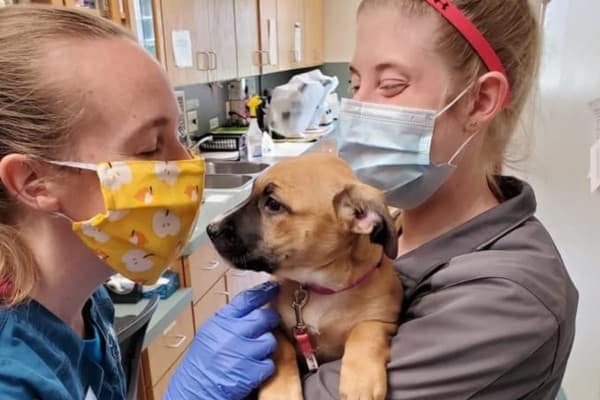
Can I take my dog to the vet during COVID-19?
Last month, the veterinary profession was completely turned on its head.
It almost feels like a lifetime ago when veterinarians’ waiting rooms were packed full of dogs on leashes and cats in carriers. Staff was scheduled to cover the six days a week that most practices are open. Vets were spaying and neutering pets, taking for granted that the masks and gloves they wore in surgery would always be available.
Today, born out of wisdom and necessity, things are different. Even when veterinary practices are open, doors may be locked because clients are asked to stay out. Many vet hospitals have split their staff into two teams that work opposing shifts. That way, if one team member has a corona exposure, which would require all of his or her coworkers to quarantine, the show can go on via the second team.
Over the past weeks, vets have been asked or required (depending on the state) to stop all non-essential surgeries and donate personal protective equipment to human hospitals. (Read this story from Cornell, Campus Community Donates Essential Medical Supplies, for one account.) For example, the governor of Colorado ordered that beginning on March 23rd, voluntary/elective procedures would be banned.
Coronavirus FAQs for Dog Owners (COVID-19)
But the scenario I paint doesn’t just impact those who work in the field of veterinary medicine. You might be reading this and wondering, “What happens if my dog gets sick?” “Is my vet open?” “Should I take my dog in for his annual health check?”
Life is full of “new norms.” Get answers on how to safely navigate working with your dog’s healthcare team during the coronavirus pandemic.
1. Is my vet open?
The answer to this question lies in a concept called “essential business.” Veterinary medicine is grappling with questions that we’ve never before faced. Are veterinary practices essential to our community infrastructure like grocery stores, gas stations, and pharmacies?
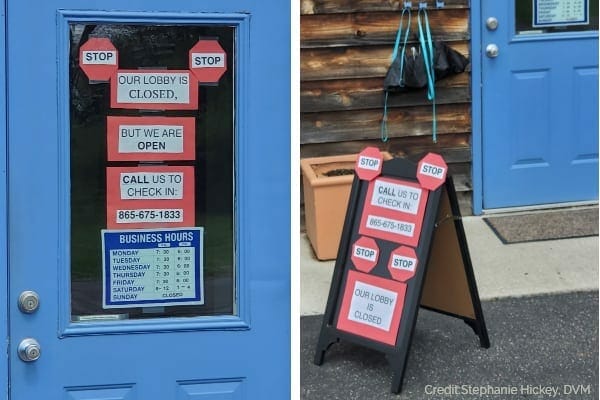
If your dog needs care during the corona crisis, I guarantee you’ll think your local veterinary clinic is an essential business. Turns out, the government agrees.
While defining what is deemed essential and non-essential business falls under state jurisdiction, The Department of Homeland Security listed veterinary clinics as essential in their master guidelines. Here’s why: clients rely on hands-on veterinary care every day. That said, there may be a better solution, at least some of the time.
Today I spoke with a friend whose wife needed medical care this week for an eye problem. She was able to work with her doctor exclusively through phone consults, pictures, and medical smartphone apps for diagnosis and treatment. Of course, this is not always possible, but it can work surprisingly well, surprisingly often…for humans and animals.
Vet telemedicine opens non-traditional doors for you
Telemedicine requires the assessment, diagnosis, and treatment plan to happen virtually. For a pet, who can’t speak for himself, it’s a bit more complex, and certainly facilitated by an observant and conscientious owner. However, telemedicine mitigates human risk in times of plague. For that reason, on March 31, the Governor of Michigan stated in his executive order: “…all veterinary services, essential and non-essential, must be performed by telemedicine to the fullest extent possible.” Other states have followed suit.
Telehealth is a fascinating emerging technology in veterinary medicine. It’s not necessarily new…there are currently over twenty companies on the market dedicated to televeterinary services. But what’s new and shocking is how widely and quickly it’s being adopted, obviously driven by the tsunami of our new corona culture. Stay tuned for next week’s blog post dedicated exclusively to televeterinary care for pets.
Is vet telemedicine an option? Determining factors
The American Veterinary Medical Association has published a flowchart to help veterinarians determine if “hands-on” care is appropriate…
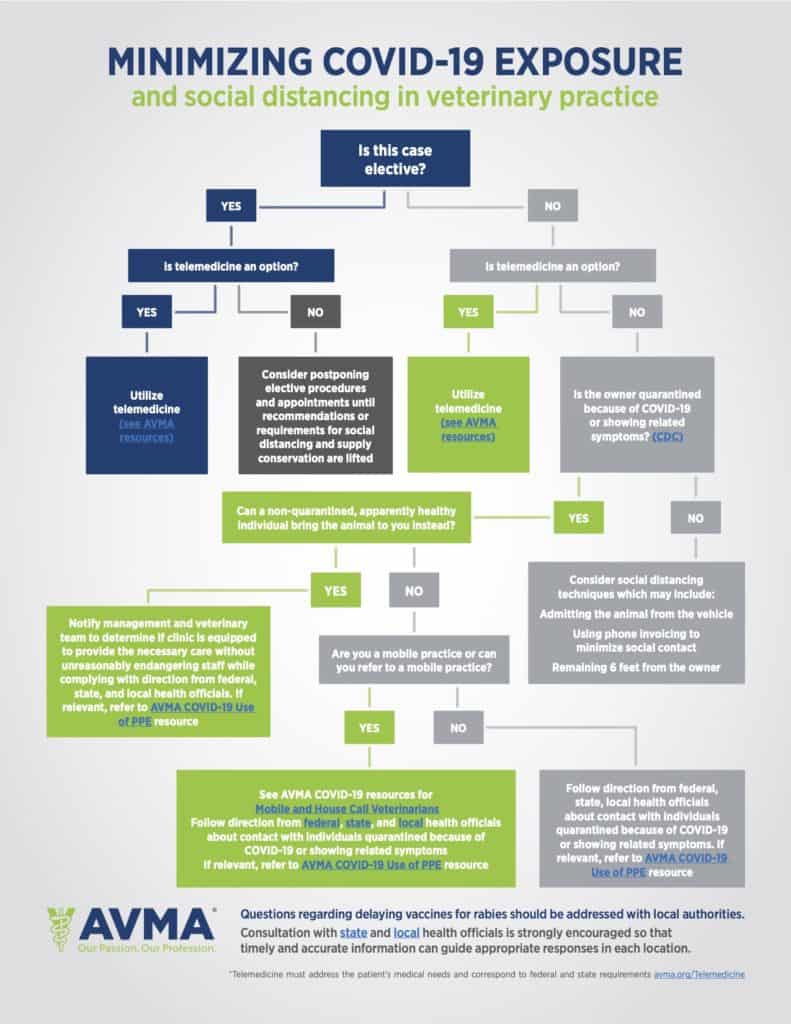
2. What if it’s time for my dog’s annual vet visit?
What about vaccines? Nail trims? Well visits?
Veterinary medicine is not business as usual, I can assure you of that. Just because veterinary businesses have been declared essential, that doesn’t mean every service vets provide is essential. (Dog nail trims are a prime example of a non-essential service.) In most states, we’ve been asked to forego the “non-essential services” to minimize risk to clients, ourselves, and our staff. And for a second reason—to conserve personal protective equipment and certain drugs for human medicine.
On March 22, Tim Atkinson, Executive Director of the New York State Veterinary Medical Society, wrote:
“Today there are animals who are going to suffer or die unless you help them. Even if there are no COVID-19 cases within 50 miles of you, there is a risk that is not yet fully understood that when you provide that care, you may infect yourself or others. It is up to how you balance that risk against which cases you accept into your hospital today.” ‘
Determining what veterinary services are “essential” is a grey area
Veterinarians are left to sort out is what are essential services. There are no formal standards, so it becomes a judgment call.
Do we spay and neuter animals? Do we see wellness appointments to give vaccinations? Do rabies vaccines take priority and qualify as essential even if other vaccines are not?
And…puppies! In most of my veterinary private discussion boards, my colleagues are reporting a huge uptick in puppy visits. World War II produced the baby boom, and Corona Quarantine is producing the puppy boom. Surely these little naive immune systems wrapped in fur need a series of vaccinations to protect from deadly diseases? All of these questions are valid.
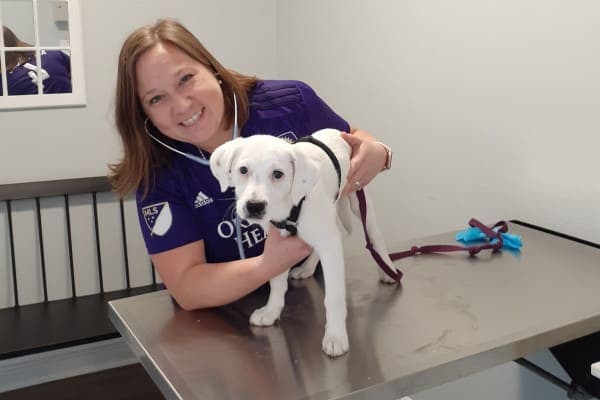
Amid the grey, some things are black and white…
If your dog is sick or injured, your veterinarian will either see your pet or advise you on where to seek emergency care. As for vaccinations and other “grey zone” care, please call your veterinarian to inquire of their current policies, which frankly, may be changing day-to-day as CDC and government updates are published.
However, here’s what I can promise you…nail trims are not essential. In other words, now is not the time to take your dog to the vet for a nail trim. But if that conjures up scary thoughts of wielding the dog nail clippers at home, only to hit the quick and hurt your dog…have no fear! With 20+ years of experience teaching my clients how to trim their dogs’ nails, I can walk you through safe, successful in-home nail trims. Check out my easy online tutorial, Dr. Buzby’s Nail Trimming Without Blood, Sweat, or Tears! [It’s usually $99 but I’m offering it to my readers for just $39 right now because I know you may not have any other options for getting your dog’s nails trimmed. This is the resource you need. Just use the promo code WAGS at checkout.]
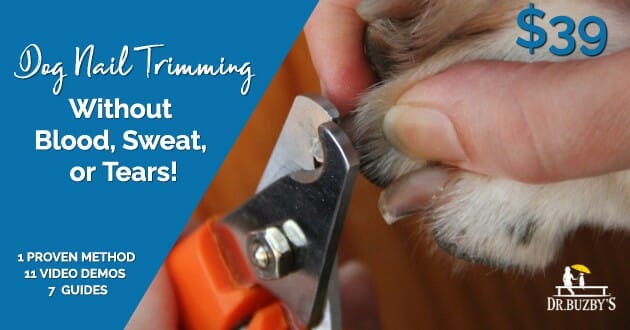
3. What is curbside care?
Like the veterinary hospital where I work, many practices are now converting to a concierge model for seeing patients. It’s similar to curbside service at Sonic except the commodity being exchanged is veterinary medicine instead of burgers and fries. Here’s an example of how curbside service is operating at Friendship Hospital for Animals in Fort Collins, Colorado:
In addition to minimizing traffic in the clinic by only seeing necessary appointments, another key strategy in coronavirus risk management is limiting client interaction. We know that human-to-human contact has the potential to spread the virus; we have no reason to believe that human-to-animal contact is a significant source of concern for transmission. [Want the details on this premise as well as the latest on coronavirus diagnoses in animals, read: Can Dogs Get Coronavirus?]
Here’s an example of how your hospital may handle things a bit differently with “car-side service”:
- Your dog’s history (pertinent information and observations that you wish to share with the veterinarian) will likely be taken in advance over the phone.
- Medical records that need to be conveyed should be faxed or scanned and emailed. If neither is possible, you can even take pictures and email them prior to the appointment.
- Your dog may be picked up directly from your car in the parking lot and returned to you there.
- Your veterinarian will then call you after the appointment to provide a synopsis of their findings and explain the plan.
Pro tip: If your next vet appointment is curbside, take a minute to print your last name on a piece of paper and place it on your dash or car window. It will help the veterinary staff identify you.
Some hospitals, like Family Pet Health in Murfreesboro, Tennessee, are taking the experience to the next level! Here owners can observe the exam in progress and communicate in real time with the veterinary staff through a Zoom conference call:
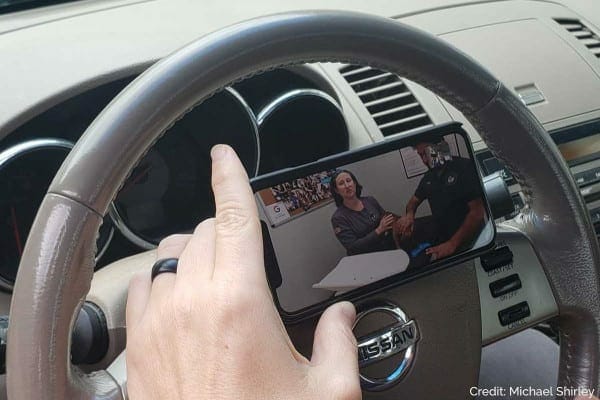
4. What if it’s time to say goodbye?
Of course, the very difficult question is what to do about euthanasia. Veterinarians take very seriously their role in guiding families through the loss of a beloved four-legged family member.
In most cases, this is the one exception that veterinarians are making to allow clients in the building. Though I pray the loss of your pet is not part of your corona quarantine experience, if you are facing this decision, please open the dialogue now with your veterinarian about your options.
5. Why is minimizing human contact to COVID-19 so important?
Read Dr. Melanie Goble’s first-hand account:
“On Tuesday, I had a difficult situation with a client. He was aggressive and spit when he spoke. He did not allow us to provide the necessary care of his pet, so I don’t know why he even came in.
As he was leaving, he announced that he has been sick – fever and upper respiratory infection – and now we are all infected. We don’t know if he was just being a jerk or being honest.
We did contact the local health department. Yesterday, I developed a cough that worsened throughout the day and a sore throat in the evening. I will be receiving my thermometer this afternoon/evening so that I will be able to monitor my temperature. I am staying in isolation for 14 days.
Please, do not go out if you are sick. Please, stay home and quarantine yourself. If you are not sick right now, remember that you are still supposed to stay home or at minimum isolate yourself by maintaining social distance of 6+ feet from others.
If you have a person or animal that needs medical care, please call ahead. Many places are doing urgent and emergency care only. Now is the time to preserve PPE (personal protective equipment) and limit exposure to others so that we can flatten the curve…”
Of course, I know this is a one-off, bizarre situation, but veterinarians have families and loved ones that they want to protect too. Curbside care is our industry’s attempt to flatten the curve.
In May of 1997, I stood on a stage wearing the quintessential cap and gown, raised my right hand, and recited the veterinary oath from memory:
Being admitted to the profession of veterinary medicine, I solemnly swear to use my scientific knowledge and skills for the benefit of society through the protection of animal health and welfare, the prevention and relief of animal suffering, the conservation of animal resources, the promotion of public health, and the advancement of medical knowledge.
I will practice my profession conscientiously, with dignity, and in keeping with the principles of veterinary medical ethics. I accept as a lifelong obligation the continual improvement of my professional knowledge and competence.
Vets care deeply about pets and pet owners
Veterinarians are public servants. We care deeply about public health…it’s in our oath! Thank you for being patient with us as we do our very best to care for you, your pets, and our staff during this challenging time.
Searching for more information on COVID-19 and dogs?
If you’re seeking care for your dog during the corona crisis, veterinary telemedicine may be an option. Please read my article, Veterinary Telemedicine: COVID-19 Ushers in a New Era for Dog Care. Learn the advantages of veterinary telehealth and whether it could be a viable solution for your dog’s medical care.
How are you navigating COVID-19 with your dog?
Please comment below. We can all learn from each other.


We welcome your comments and questions about senior dog care.
However, if you need medical advice, diagnosis, or treatment, please contact your local veterinarian.